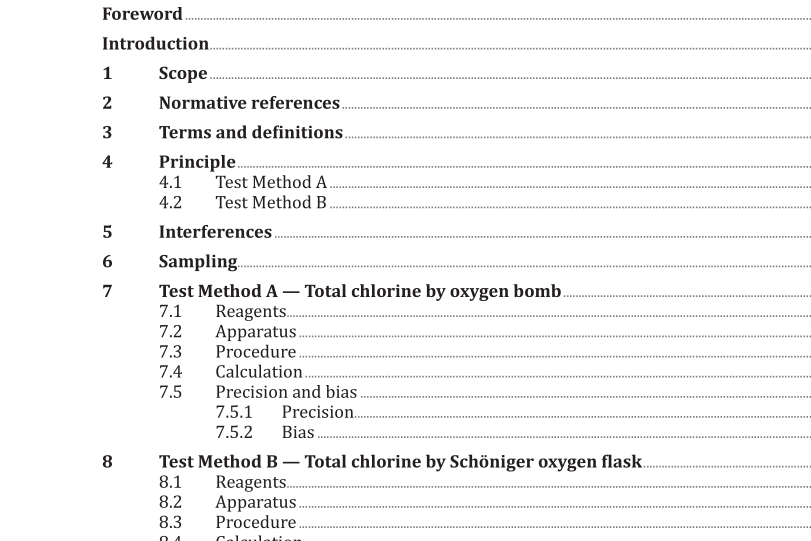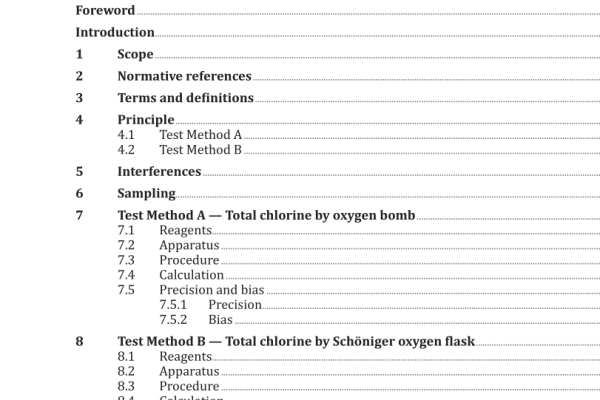ISO 26603:2017 pdf download – Plastics — Aromatic isocyanates for use in the production of polyurethanes — Determination of total chlorine.
3.4 total chlorine inorganic and organically bound chlorine present in isocyanates that is converted to titratable chlorides under the combustion conditions of the test 4 Principle In each test method, the organic matter in the sample is destroyed by combustion with oxygen, thus converting the organically combined chlorine to ionic chloride. The chloride is determined potentiometrically by titration with silver nitrate (AgNO 3 ) solution. 4.1 Test Method A Combustion of the sample is done in a pressurized oxygen bomb. 4.2 Test Method B Combustion is done at atmospheric pressure in a Schöniger oxygen flask. NOTE For information on the Schöniger flask, see Reference [6]. 5 Interferences Thiocyanate, cyanide, sulphide, bromide, iodide or other substances capable of reacting with silver ion, as well as substances capable of reducing silver ion in acid solution, will interfere with the determination. 6 Sampling Since organic isocyanates react with atmospheric moisture, take special precautions in sampling. Usual sampling methods, even when conducted rapidly, can expose the isocyanate to moisture and cause contamination of the sample with insoluble ureas; therefore, blanket the sample with a dry inert gas (e.g. nitrogen, argon or dried air) at all times. WARNING? —? Organic? isocyanates? are? hazardous? when? absorbed? through? the? skin,? or? when? the? vapours are breathed. CAUTION — Provide adequate ventilation and wear protective gloves and eyeglasses. 7 Test Method A — Total chlorine by oxygen bomb 7.1 Reagents 7.1.1 Purity of reagents Reagent-grade chemicals shall be used in all tests. Other grades may be used, provided that it is first determined that the reagent is of sufficiently high purity to permit its use without lessening the accuracy of the determination. Unless otherwise indicated, it is intended that all reagents shall conform to the specifications of ISO 6353-2 and ISO 6353-3. 7.1.2 Purity of water Unless otherwise indicated, references to water shall be understood to mean grade 2 water as defined by ISO 3696.
7.1.3 Ethyl alcohol, conforming to ISO 6353-2. 7.1.4 Nitric acid (diluted). While stirring vigorously, add 100 ml of nitric acid (HNO 3, specific gravity 1,42) to 100 ml of water cooled in an ice bath. 7.1.5 Oxygen, free of combustible materials and halogen compounds. 7.1.6 Silver nitrate, standard solution (0,01 M). Prepare a 0,01 M silver nitrate (AgNO 3 ) solution and check frequently enough to detect changes of 0,000 5 M, either gravimetrically or potentiometrically, using standard hydrochloric acid (HCl). 7.1.7 Sodium carbonate solution (50 g/l). Dissolve 135 g of sodium carbonate decahydrate (Na 2 CO 3 ·10H 2 O) in water and dilute to 1 l. 7.2 Apparatus 7.2.1 Weighing bottle and balance, suitable for weighing a liquid sample by difference to the nearest 0,5 mg. 7.2.2 Oxygen bomb apparatus. A corrosion-resistant steel reactor capable of being pressurized to 40 atmospheres of pure oxygen, followed by electrical ignition of the sample by use of an internal fuse wire. The bomb shall be capable of withstanding the pressure build-up caused by the combustion of the sample. Parr Bomb No. 1108 is a suitable device (see Figure 1). Equivalent apparatus may be substituted with appropriate changes in the procedure. 7.2.3 Fuse wire, iron-nickel-chromium, No. 34 B and S gage. 7.2.4 Titrimeter, automatic (preferred) or manual, equipped with a silver/silver chloride electrode pair and a 10 ml capacity microburette. 7.2.5 Bubble counter, a 100 ml graduate and delivery tube, or a bent “L” glass tube connected to a piece of rubber tubing. The graduate is filled to the 50 ml mark with water to which 3 ml of 0,1 M AgNO 3 and 1 drop of concentrated nitric acid have been added. Any turbidity that develops indicates that HCl gas is being lost when venting the bomb.
ISO 26603:2017 pdf download – Plastics — Aromatic isocyanates for use in the production of polyurethanes — Determination of total chlorine






